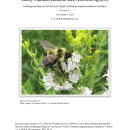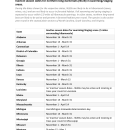Image

Interagency Cooperation (Section 7) Coordinator
Additional roles
Candidate Conservation Agreements with Assurances Coordinator
Safe Harbor Coordinator
Areas of expertise
Section 7 Consultation
Candidate Conservation Agreements
Safe Harbor Agreements
Endangered Species Conservation
Development of Conservation Agreements
Pollinator Conservation - Monarchs, Rusty-Patched Bumble Bee, Dakota Skipper




